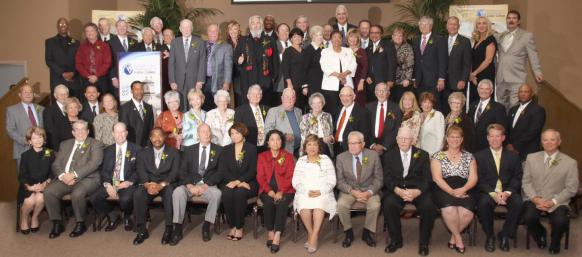2007-2012
The Daniels Presidency, 2007-2012
Dr. Debra Daniels became San Bernardino Valley College’s 12th permanent president in September 2007. Daniels came to Valley from Polk Community College in Winter Haven, Florida, where she was district vice president of academics and student affairs. At Polk, Daniels reorganized student services into a one-stop service, an idea that would be carried over to Valley.
A hallmark program of the Daniels presidency was Valley-Bound Commitment, which was launched in fall 2008. Valley-Bound provides a free first year of college (including fees, books, parking, and other expenses) to eligible students from local high schools, with a goal of increasing student success and the region’s college-going rate. In its first three years, the Valley-Bound class went from 36 to 150 students; each group maintained high GPAs, stayed in college at a higher rates, and donated thousands of hours of community service as part of their commitment to the program. The San Manuel Band of Mission Indians provided substantial support to the Valley-Bound Commitment Program, about $450,000 over three years. The program was also supported by campus and community fundraisers. In 2010, Valley-Bound Commitment was the sole recipient of the State Chancellor’s Office Student Success Program of the Year, recognizing a college that demonstrates significant progress toward achieving student equity and success goals.
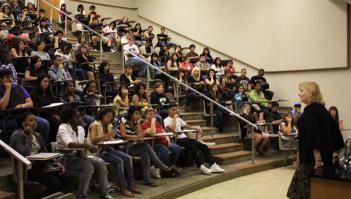
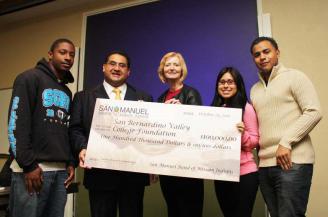
Another student-success-focused program, Middle College High School, a collaboration between Valley College and the San Bernardino City Unified School District, garnered national recognition with a bronze medal from U.S. News & World Report in its first ranking of America’s best high schools. It also received the Title I Academic Achievement Award and was named a 2007 California Distinguished School.
Valley’s efforts as a Hispanic Serving Institution were nationally recognized during Daniel’s tenure. Valley received a five-year cooperative STEM grant--it’s largest ever, at a combined $5.5 million--from the U.S. Department of Education, awarded through the Hispanic Serving Institutions program. Valley is the lead institution, with CSUSB, to improve and expand programs to Hispanic students by increasing enrollment, graduation, and transfer rates. Furthermore, the March 2011 issue of Hispanic Outlook in Higher Education ranked Valley College in the top 50 of U.S. community colleges for serving Hispanic students and faculty in the categories of Hispanic full-time enrollment, number of associate’s degrees granted to Hispanics, and number of Hispanic faculty members.
Valley received substantial support for program development from local and national organizations. In 2007, SBVC received a grant to help area high school seniors pass the California High School Exit Exam. The grant initially helped about 400 students but created activities to help future students after the grant expires. With the Inland Empire’s thriving logistics and freight transportation industries, the San Bernardino County Workforce Investment Board discovered a high demand for diesel truck mechanics. As such, the board awarded 20 students $1,000 each for tuition, books, and tools toward finishing Valley College’s fleet maintenance program. Southern California Edison launched a $1 million Green Jobs Education initiative, with $100,000 to 10 colleges, including Valley, for scholarships for students in the Water Supply Technology or Geographic Information Systems programs. In 2010, Valley was awarded a Student Support Services grant for $1.5 million over five years from the U.S. Department of Education for reauthorization of the STAR (Success Through Achievement and Retention) Program. This successful program was first funded in 1993 and provides support services tailored to the needs of students from under-represented groups.

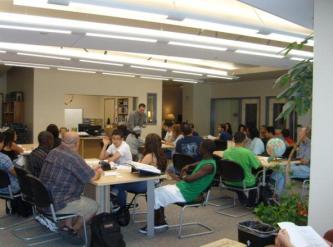
In a broader context, Daniel’s presidency was marked by a statewide and national recession that hit communities like San Bernardino and public educational institutions particularly hard. The economic crisis that started in 2007 had a profound impact on Valley College. Across the state and in the Inland Empire, people were returning to college to improve their job skills and increase their chances of employment. At Valley College, student enrollment increased substantially even with continually rising student fees and overcrowded classrooms. Coping with severe state budget cuts and surging enrollment, Valley College cut classes and programs and offered early retirements.
As the economy started to recover, so too did Valley College. On campus, services continued to be streamlined and automated, saving students considerable time and frustration. Admissions & Records initiated the FastPass program for student appointments, which helped eliminate long lines for registration and other services. WebAdvisor was launched to streamline the financial aid process, giving students round-the-clock access to account services. The expanded Student Success Center began offering tutoring when it opened in the new Physical Sciences Building.
The campus environment continued to change and settle, as projects initiated during the earthquake reconstruction and retrofitting program wrapped up. The new Student Health Center opened in 2008, and in 2009-2010, four new buildings were completed and dedicated: Custodial, Maintenance & Operations, North Hall, and Media & Communications. In 2011, the last of twelve new buildings opened: Physical Science, the campus’s first Leadership in Energy and Environmental Design (LEED)-certified building. The Diesel Program moved back to campus after eight years at the former Norton Air Force Base. Measure P was crucial to finishing this campus transformation.
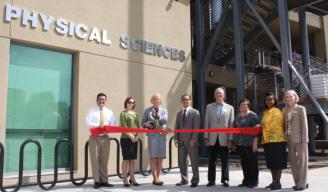

During the Daniels presidency, student activists had many reasons to engage politically. In 2009, students travelled to Sacramento for the annual Rescue Education rally. On Pink Friday, all of the San Bernardino school system protested Gov. Schwarzenegger’s proposed $4.8 billion cut to the state’s education budget and the resulting pink slips given to school staff and teachers. Changes to immigration law provoked fear and uncertainty for many Valley College students. With AB 540 looming, students with undocumented status faced out-of-state instead of the promised in-state fees, a difference of $175 per unit. The MEChA Latino faculty and staff and the Arts and Lecture Committee hosted a lecture by Dolores Huerta; she encouraged students to continue working in political movements and to vote. In 2012, MEChA sponsored a Day of Action to highlight ongoing issues at Valley, such as a lack of classes, resources, and full-time faculty. To encourage participation in the 2010 Census, RTVF students wrote, produced, acted in, and edited a 30-second PSA.
There were many reasons to celebrate campus achievements. In January 2011, the campus and community gathered for the Dr. Martin Luther King, Jr. Breakfast, where the “Commitment to Diversity” Dream Award is presented to individuals committed to promoting diversity, human rights, and cultural understanding at the college and in the community. This annual breakfast kicks off Black History Month in February, with free educational and cultural events organized by the SBVC Black Faculty & Staff Association; the Arts, Lectures & Diversity Committee; the Black Student Union; and the Tumaini Program.
In 2010, the women’s soccer team won its first California Community College Athletic Association Women’s Soccer State Championship in the school’s history, and its third straight Foothill Conference title. The team was honored by the San Bernardino City Council. The Psychiatric Technician Program was recognized by the California Board of Vocational Nursing as the top-ranked school in percentage of students passing their licensing exams after completing college coursework. From the fall 2011 program, all 22 graduates passed. This 100% pass rate is the highest of any California school. In October 2011, Valley College celebrated is 85th anniversary with a gala at the National Orange Show Events Center, raising more than $30,000 for the Valley-Bound Commitment Program from sponsorships and reverse auction. The event celebrated Valley’s rich history and recognized 86 People of Distinction--alumni and friends of the college.
